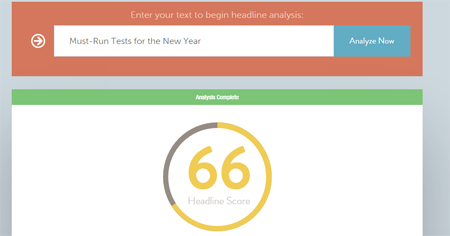Must-Run Tests for the New Year

Nearly anything could be tested in 2015 and almost everything was tested in savvy, conversion-focused enterprises.
Not all companies were quite so lucky, however, with a variety of people and processes holding them back from running tests that could improve their bottom lines.
While there will still be legacy systems, old ways of thinking, and limited time and resources preventing companies from running all the tests they want to in the New Year, here's a quick list of must-run tests for every organization.
Email Subject Lines
Email is still one of the top producers of website traffic and conversions for digital companies, making it imperative that senders test their email subject lines. Too often marketers fall into a rut of scheduling email campaigns with subject lines they think will work best, based on personal experience.
It doesn't take much work at all to A/B test a subject line so that the majority of recipients receive the "winning" subject line that entices more opens. A/B testing subject lines has, of course, been a must-run test for years, but it's one too often forgotten about as marketers go about their daily routines.
Brands can take email subject line testing a step further by segmenting their lists (e.g. A/B test a subject line to those who often open their emails versus those who do so a lot less frequently...if ever).

Social Media Posts
Everything on social media can and should be tested, from the timing of posts to who sees what. Facebook makes testing posts particularly easy, because marketers can (and should) send different messages to different groups.
For instance, if a B2B company wants its followers to download a whitepaper (that requires the user to fill out a form), they can send this message, "Access our free whitepaper about ___ now at (link)" to one demographic (e.g. males under 40) and another message, "Download our free whitepaper about __ at (link) - form completion required" to another demographic (e.g. males over 40). One age group, for instance, might appreciate the warning that a form is required to be able to download the whitepaper, while another age group might not care.
Facebook allows for some pretty sophisticated targeting for free, organic posts and goes into even more specifics when advertising dollars are involved. Marketers would be wise to test messaging to different groups (such as based on gender, age, location).
Blog Headlines
While not all content management systems (CMS) support the testing of blog headlines, many of today's more modern CMSs do. This capability should be taken advantage of, as traditionally blog/article headlines have been produced based on a writer's gut feeling of what will resonate with readers.
A modern CMS can take the guesswork out of the equation by allowing a content marketer to suggest a few different headlines and then the CMS will serve the most engaging headline to the larger audience. Other tools like CoScheduler will also allow marketers to test their headlines by analyzing length, keywords, sentiment and more.

Calls to Action
From size and shape to color and copy, there's a lot that can impact the effectiveness of a call to action (CTA). While there are some standard best practices for CTAs - prominent, bold, relevant, etc. - most enterprises won't know if one CTA choice is better than the other until they test audience repsonse.
VWO and Optimizely are both good testing options, as is a person's marketing automation platform like HubSpot. CTAs should not be published without testing different elements to see which causes the most positive actions.
Landing Pages
Savvy marketers know that personalizing a Web experience is ideal in 2016, but many are forced to work with legacy software not conducive to providing this type of modern experience. Still, many have some control over what is presented to basic groups - like new and returning visitors.
By testing landing pages for different groups they can provide a very basic personalized experience, which is better than nothing. They can test returning users' propensity toward staying on the site if they are presented with a "welcome back" message or what they viewed last time they visited as opposed to the same experience a new visitor would have.
VWO, for example, reports that one of its clients increased sales by 86 percent simply by moving its Help Section above the fold, this is something a company can test with different visitor segments - perhaps those who have visited and not converted versus first-time visitors.

While this is not an exhaustive must-test list by any means, the ideas above are must-run tests for the New Year.

Subscribe to Our Newsletter!
Latest in Marketing









